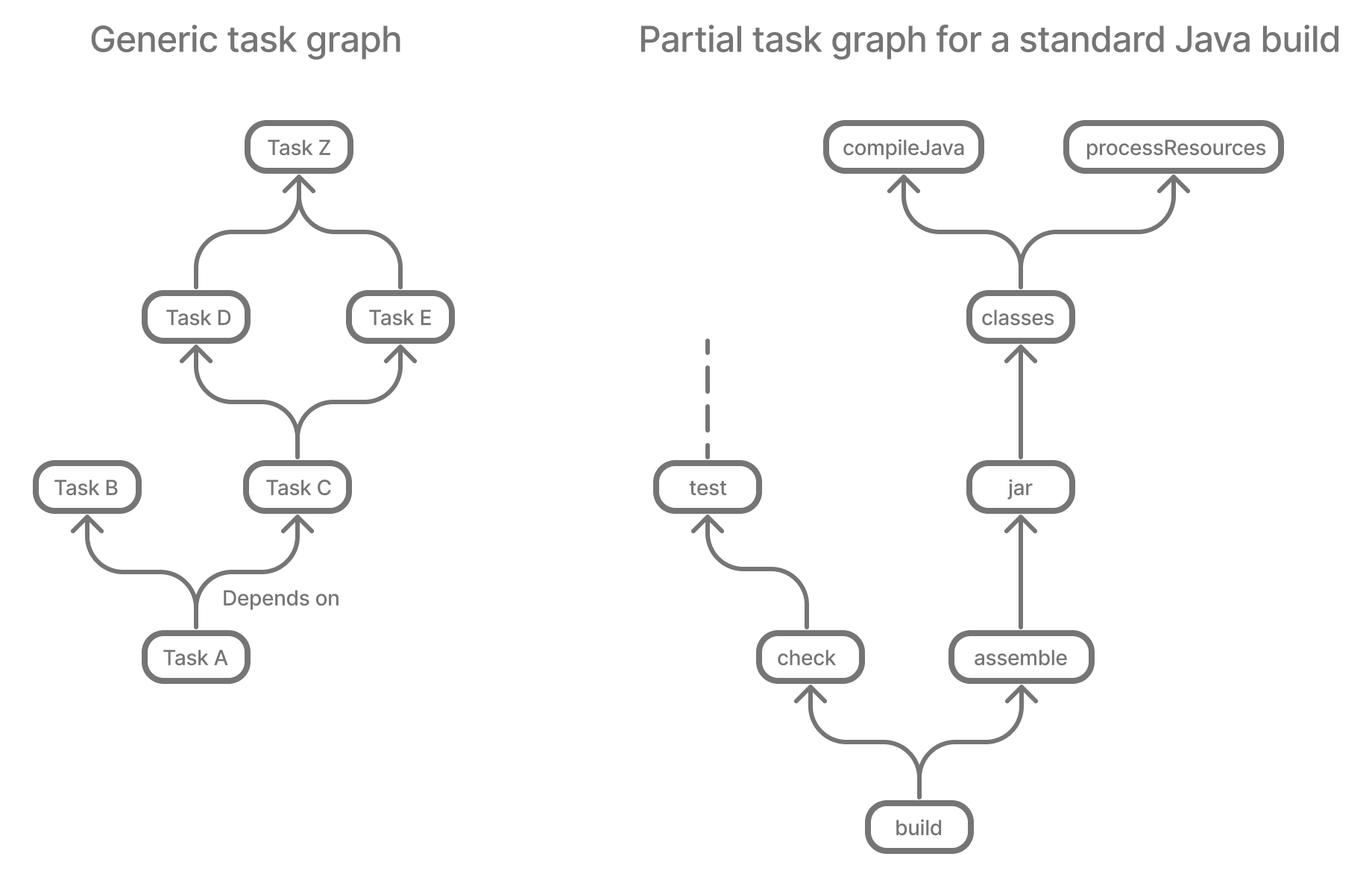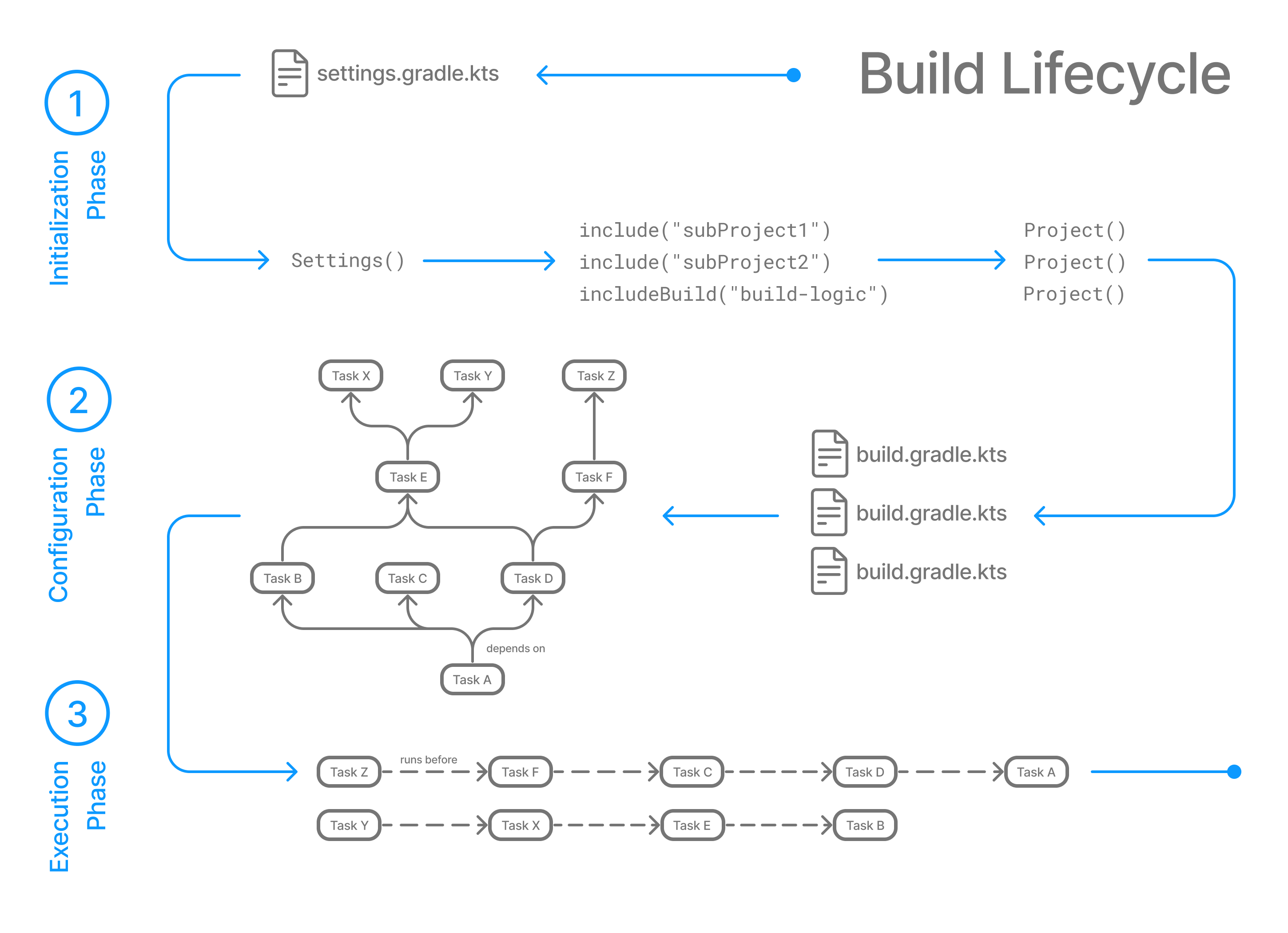Build Lifecycle
As a build author, you define tasks and dependencies between tasks. Gradle guarantees that these tasks will execute in order of their dependencies.
Your build scripts and plugins configure this dependency graph.
For example, if your project tasks include build, assemble, createDocs, your build script(s) can ensure that they are executed in the order build → assemble → createDoc.
Task Graphs
Gradle builds the task graph before executing any task.
Across all projects in the build, tasks form a Directed Acyclic Graph (DAG).
This diagram shows two example task graphs, one abstract and the other concrete, with dependencies between tasks represented as arrows:

Both plugins and build scripts contribute to the task graph via the task dependency mechanism and annotated inputs/outputs.
Build Phases
A Gradle build has three distinct phases.

Gradle runs these phases in order:
- Phase 1. Initialization
- Phase 2. Configuration
-
-
Evaluates the build scripts,
build.gradle(.kts), of every project participating in the build. -
Creates a task graph for requested tasks.
-
- Phase 3. Execution
-
-
Schedules and executes the selected tasks.
-
Dependencies between tasks determine execution order.
-
Execution of tasks can occur in parallel.
-

Example
The following example shows which parts of settings and build files correspond to various build phases:
rootProject.name = "basic"
println("This is executed during the initialization phase.")println("This is executed during the configuration phase.")
tasks.register("configured") {
println("This is also executed during the configuration phase, because :configured is used in the build.")
}
tasks.register("test") {
doLast {
println("This is executed during the execution phase.")
}
}
tasks.register("testBoth") {
doFirst {
println("This is executed first during the execution phase.")
}
doLast {
println("This is executed last during the execution phase.")
}
println("This is executed during the configuration phase as well, because :testBoth is used in the build.")
}rootProject.name = 'basic'
println 'This is executed during the initialization phase.'println 'This is executed during the configuration phase.'
tasks.register('configured') {
println 'This is also executed during the configuration phase, because :configured is used in the build.'
}
tasks.register('test') {
doLast {
println 'This is executed during the execution phase.'
}
}
tasks.register('testBoth') {
doFirst {
println 'This is executed first during the execution phase.'
}
doLast {
println 'This is executed last during the execution phase.'
}
println 'This is executed during the configuration phase as well, because :testBoth is used in the build.'
}The following command executes the test and testBoth tasks specified above.
Because Gradle only configures requested tasks and their dependencies, the configured task never configures:
> gradle test testBoth
This is executed during the initialization phase.
> Configure project :
This is executed during the configuration phase.
This is executed during the configuration phase as well, because :testBoth is used in the build.
> Task :test
This is executed during the execution phase.
> Task :testBoth
This is executed first during the execution phase.
This is executed last during the execution phase.
BUILD SUCCESSFUL in 0s
2 actionable tasks: 2 executed> gradle test testBoth
This is executed during the initialization phase.
> Configure project :
This is executed during the configuration phase.
This is executed during the configuration phase as well, because :testBoth is used in the build.
> Task :test
This is executed during the execution phase.
> Task :testBoth
This is executed first during the execution phase.
This is executed last during the execution phase.
BUILD SUCCESSFUL in 0s
2 actionable tasks: 2 executedPhase 1. Initialization
In the initialization phase, Gradle detects the set of projects (root and subprojects) and included builds participating in the build.
Gradle first evaluates the settings file, settings.gradle(.kts), and instantiates a Settings object.
Then, Gradle instantiates Project instances for each project.
Phase 2. Configuration
In the configuration phase, Gradle adds tasks and other properties to the projects found by the initialization phase.
Phase 3. Execution
In the execution phase, Gradle runs tasks.
Gradle uses the task execution graphs generated by the configuration phase to determine which tasks to execute.
Next Step: Learn how to write Settings files >>